-
OAHoe kijken Vlaamse recruiters naar jobkandidaten met een kankerervaring?
- Amsterdam University Press
- Source: Tijdschrift voor Arbeidsvraagstukken, Volume 39, Issue 1, mrt. 2023, p. 4 - 21
-
- 01 mrt. 2023
Samenvatting
In deze studie bestuderen we discriminatie van overlevenden van kanker, met een focus op de onderliggende mechanismen, bij Vlaamse selectieverantwoordelijken. Daartoe repliceren we een vignetten-experiment dat eerder bij Amerikaanse en Britse recruiters werd uitgevoerd. We vinden dat een werkonderbreking op het cv door een kankerervaring effectief schadelijk is voor de aanwervingskansen. Vooral de vrees dat wie een kankerervaring achter de rug heeft nieuw ziekteverzuim zal laten optekenen verklaart hun lagere kansen bij het solliciteren. Tegelijk worden jobkandidaten met een kankerervaring gezien als gemotiveerder dan wie geen gat op het cv heeft. Tegenover andere kandidaten met een gat op het cv om andere redenen (eerdere depressie, familiale reden of niet-toegelichte werkonderbrekingen), blijft enkel het stigma van hogere kansen op ziekteverzuim (behalve tegenover wie een depressie had) over. In vergelijking met hen hebben gewezen kankerpatiënten betere aanwervingskansen. Ze worden door de Vlaamse recruiters onder andere beter ingeschat qua motivatie, autonomie, flexibiliteit en stressbestendigheid.


